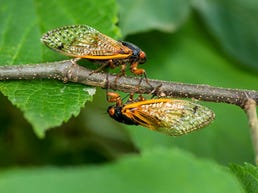For many Americans, the cicadas are here.
Trillions of periodical cicadas are already emerging in a rare, two brood event across multiple states, with more expected to come in the following weeks. Thanks to warm temperatures and good conditions, these 13- or 17-year cicadas are emerging from their underground habitats to eat, mate and die, making a whole lot of noise in the process.
Broods XIX and XIII have not emerged together since 1803, and after this year, won’t emerge together again until 2245. While they are largely in different states, they are both emerging in parts of Illinois and Iowa.
So if you’ve seen one cicada or hundreds of cicadas, here’s where you can expect to see more this year.
Are cicadas dangerous?Busting myths on the harmfulness of the noisy pests.
Are cicadas already out in 2024?
Adult periodical cicadas from Brood XIX have been spotted by users in multiple states across the Southeast and Midwest including in Missouri, Arkansas, Oklahoma, Mississippi, Alabama, Georgia, South Carolina, North Carolina, Tennessee, Kentucky, Virginia and Illinois, according to Cicada Safari, a cicada tracking app developed by Mount St. Joseph University in Cincinnati, Ohio.
Cicada Safari users have also identified Brood XIII cicadas in Illinois and Iowa.
Through Cicada Safari, users can confirm their sightings of cicadas with pictures, look at a map of other cicada sightings, join a leaderboard with other users and learn more information about cicadas.
2024 cicada map: Check out where Broods XIII, XIX are projected to emerge
The two cicada broods are projected to emerge in a combined 17 states across the South and Midwest. They emerge once the soil eight inches underground reaches 64 degrees, expected to begin in many states in May and lasting through late June.
The two broods last emerged together in 1803, when Thomas Jefferson was president.
What is a brood?
According to the University of Connecticut, broods are classified as “all periodical cicadas of the same life cycle type that emerge in a given year.”
A brood of cicadas is made up of different species of the insect that have separate evolutionary histories. These species may have joined the brood at different times or from different sources. These different species are lumped together under the brood because they are in the same region and emerge on a common schedule.
Why do cicadas make so much noise?
You’ll have to thank the male cicadas for all that screeching. Male cicadas synchronize their calls and produce congregational songs, according to Britannica, which establish territory and attract females. There is also a courting call that they make before mating.
Unluckily for us, the 13-year and 17-year brood cicadas are the loudest, partially because of the sheer number of them that emerge at once.




